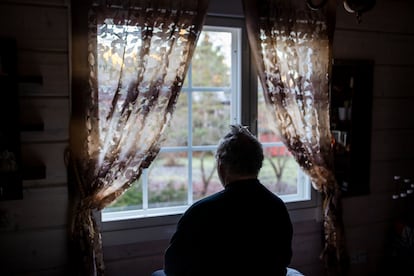Emotional distress has increased worldwide over the past decade
A new study shows that there has been a 6% overall increase in feelings of worry, sadness, stress or anger caused by the Covid pandemic, financial crises and social inequality

Emotional distress has increased on a global scale according to a study published in the scientific journal PNAS. The data, collected through telephone surveys conducted by U.S.-based consultancy Gallup, show that while in 2009, 25% of people acknowledged having feelings of worry, sadness, stress, or anger over the course of the previous day, in 2021 that figure had risen to 31%. Over 1.5 million people in 113 countries participated in the interviews.
The data, analyzed by Michael Daly and Lucia Macchia of Maynooth University in Ireland, suggest that people with lower socioeconomic status have poorer mental health. In the final year covered by the study, there was a more than ten-point difference between the richest 20% of the population and the poorest 20%. A more rapid deterioration in the mental state of people with only a basic education compared to those with high school or university level qualifications was also detected.
During the Covid-19 pandemic, there was a 2.5% increase in the number of people reporting anxiety. From that peak the number declined in 2021, although the figures remained higher than those recorded in pre-pandemic data. The study also indicates that the pandemic had a different impact depending on age. Figures continued to worsen year-on-year among those 55 or over but, according to the data, this demographic did not suffer as marked a deterioration as those under that age. Under-35s were the least affected group over the entire study period, but during the coronavirus pandemic they surpassed those over 55 and neared the figures reported by those between 35 and 55, who are the most anxious age group overall.
After the pandemic, although general emotional distress declined, young people — whose negative feelings experienced a growth of four points compared to the average of 2.5 during Covid — did not return to third place on the anxiety scale. The study, like others previously published, also observed that women suffered a longer-lasting psychological impact during the pandemic than men.
The authors state that their results are “in line with evidence from longitudinal studies indicating that the pandemic had an adverse psychological effect which was small in magnitude.” Furthermore, “the pandemic-related increase in distress found in this study was short lived,” a result consistent with other findings suggesting that “populations flexibly adapted to the stressful circumstances of the pandemic and recovered relatively quickly from the distressing impact of the initial lockdown period.”
As for the reasons behind the negative trend in mental health around the world, Daly believes that “many factors may be involved, which vary by country and period.” Among other reasons, the researcher points to the consequences of the 2008 financial crisis, which caused “job insecurity and debt problems for many people,” as well as political instability in many parts of the world. Daly also mentions “concern about the decline of social cohesion in some countries, reflected in isolation and loneliness that can contribute to a sense of distress.”
Lastly, Daly points to the possible role of the “technological environment, with the associated increase in information, demands for productivity or comparison with others” as another source of emotional distress, and acknowledges that increased awareness of mental health issues may be making problems that previously existed but were not measured more visible.
“Mental disorders are closely linked to economic and social inequalities”
Carmen Rodríguez Blázquez, a researcher at the National Epidemiology Center at the Carlos III Health Institute in Madrid, believes that “no one has an explanation” for the trend shown by studies such as Daly and Macchia’s paper. “There are always many factors to take into account with emotional disorders and illnesses, such as economic crises, which always have an effect, and the increased awareness of mental health issues, which we especially witnessed as a consequence of the pandemic,” she says. Rodríguez Blázquez agrees with the data reflected in the study showing a worsening of the situation among people with less education and fewer resources. “Mental disorders are closely linked to economic and social inequalities and to lack of resources, and this is evident in study after study,” she says.
The psychologist also believes the data showing an increase in mental suffering “may be the result of a greater awareness of a problem, something that can be useful for people to seek help.” However, she adds that “if we raise awareness of mental disorders, but do not increase the amount of resources to deal with the problem, this awareness can be counterproductive because it generates frustration, and that is what is happening.”
Together with the increase in resources dedicated to making psychologists or psychiatrists more accessible, the data reflected in the Gallup surveys show that economic and social development itself, in principle, should translate into better mental health. However, data such as suicide rates, which are very high in highly developed countries such as Scandinavia yet lower in Southern Europe and North Africa, show the complexity of the problem — something global studies on the scale of the PNAS investigation will be useful tool toward fully understanding — and the futility of seeking simple answers. Economic progress is often accompanied by a change in the social context, which reinforces individualism. “In Spain, family and social support provides protection against some mental health problems, but we are becoming more and more like the Nordic countries,” says Rodríguez Blázquez.
Sign up for our weekly newsletter to get more English-language news coverage from EL PAÍS USA Edition
Tu suscripción se está usando en otro dispositivo
¿Quieres añadir otro usuario a tu suscripción?
Si continúas leyendo en este dispositivo, no se podrá leer en el otro.
FlechaTu suscripción se está usando en otro dispositivo y solo puedes acceder a EL PAÍS desde un dispositivo a la vez.
Si quieres compartir tu cuenta, cambia tu suscripción a la modalidad Premium, así podrás añadir otro usuario. Cada uno accederá con su propia cuenta de email, lo que os permitirá personalizar vuestra experiencia en EL PAÍS.
¿Tienes una suscripción de empresa? Accede aquí para contratar más cuentas.
En el caso de no saber quién está usando tu cuenta, te recomendamos cambiar tu contraseña aquí.
Si decides continuar compartiendo tu cuenta, este mensaje se mostrará en tu dispositivo y en el de la otra persona que está usando tu cuenta de forma indefinida, afectando a tu experiencia de lectura. Puedes consultar aquí los términos y condiciones de la suscripción digital.
More information
Últimas noticias
Most viewed
- Alain Aspect, Nobel laureate in physics: ‘Einstein was so smart that he would have had to recognize quantum entanglement’
- Maps of the US attack on Venezuela: Targets, airspace and deployed fleet
- David King, chemist: ‘There are scientists studying how to cool the planet; nobody should stop these experiments from happening’
- Key points of the military attack on Venezuela: Early morning bombings and a ‘captured’ president
- Maduro jailed in New York after his capture in Caracas











































